From foe to friend: forest co-management scheme of forests by tribe and government
19.10.2023
SUBMITTING ORGANIZATION
Miaoli County Saisiyat Indigenous Peoples Forestry and Worker Limited Liability Cooperative
OTHER CONTRIBUTING ORGANIZATIONS
Hsinchu Forest District Office, Forestry Bureau, Council of Agriculture, Executive Yuan
DATE OF SUBMISSION
04/07/2023
REGION
Asia
COUNTRY
Chinese Taipei
KEYWORDS
Forest co-management, placemaking, benefits, local sustainability
AUTHORS and AFFILIATIONS
- Chih-You Ken: Chair of the Board, Miaoli County Saisiyat Indigenous Peoples Forestry and Worker Limited Liability Cooperative
- Wei-Chen Ken: Industry Chief Operating Officer, Miaoli County Saisiyat Indigenous Peoples Forestry and Worker Limited Liability Cooperative
- Wei-Ting Ken: Manager, Miaoli County Saisiyat Indigenous Peoples Forestry and Worker Limited Liability Cooperative
- Hwa-Ching Lin: Director General of the Forestry Bureau, Council of Agriculture, Executive Yuan
- Jung-Sheng Hsia: Director, Hsinchu Forest District Office, Forestry Bureau, Agriculture Committee, Executive Yuan
- Kuang-Chung Lee: Professor, National Dong Hwa University
Summary Sheet
The summary sheet for this case study is available here.
1. Background
1.1 Socioeconomic characteristics
In 1970s, the Saisiyat tribes in the Penglai Village came into a long-term resource use conflict with the Hsinchu Forest District Office of the Forestry Bureau. Due to the government regulations that prohibited the use of forest resources, tribal socio-economic development stagnated and the youth was out-migrating to urban areas. This caused a significant population decline, cultural discontinuity and mismanagement of mountain and forest resources. Up until 2010s, it was common for the local people to engage in illegal logging activities due to the lack of alternative sources of income. Consequently, this led to several other problems, among which was the conflict between the Saisiyat and the government. Thus, the Saisiyat people used the term “Hawen” (meaning “devil”) to refer to the Forestry Bureau.
There are 10 Saisiyat tribes in Penglai Village. According to the census performed by the Saisiyat Cooperative in 2018, the total population is 1004, including 479 people of the Chinese Han descent and 525 people of the Indigenous descent. About 150 people reside in the tribe on a permanent basis, of which 70% are elderly, 13% – middle-aged , 3% – young, and 14% – children (under 16 years old).
For many years, the Saysiyat people has been restricted by legal limitations in the utilization of natural resources within their traditional territory, such as logging and hunting, leading to constant conflicts with Hsinchu Forest District Office. The lack of dialogue and communication between the Saysiyat people and the forest authorities has caused them to view Forestry Bureau as a demon and an enemy. In 2016, President Tsai, on behalf of the government, issued an apology to the indigenous peoples, marking a new milestone in government-indigenous relations. Subsequently, Forestry Bureau has reviewed and relaxed regulations, and implemented a series of policy measures aimed at promoting joint management, sharing, and prosperity of mountain and forest resources. The goal is to reestablish the once close relationship between the indigenous peoples and the mountains.
On February 7, 2018, the Saisiyat were willing to try to break the cycle. They held a partnership signing ceremony with the Forestry Bureau in the “Legislative Yuan” to formally declare to all that in the future they would seek the sustainable development of tribe and forest through mutual trust, mutual assistance, and sharing, and that they would work together with the framework of the Satoyama Initiative.
1.2 Environmental characteristics
Saisiyat elders used to say: ‘The human beings are a part of nature and coexist with nature’. Protecting the forests has thus been a key commandment of the Saisiyat people for generations. This firm belief in the need to take care of their natural environment was true even in era of intensive logging (1920-1970). The Saisiyat tribal groups of Penglai Village are located on the mountain called Jiali Shan, which is known as Mount Fuji in Taiwan (Figure 1). This is where the Saisiyat people live. Their surrounding environment comprised of unique forested landforms and biodiversity forms a one-of-a-kind nature-culture relationship for the tribal communities. Saisiyat connection to the natural environment is reflected in tribal education system, knowledge of medicinal herbs and plants, coming-of-age ceremonies, and traditional sacrifices. The ruins of the old tribes and ancestral burials are scattered over the vast forested landscape, uniting with it and preserving its wisdom.
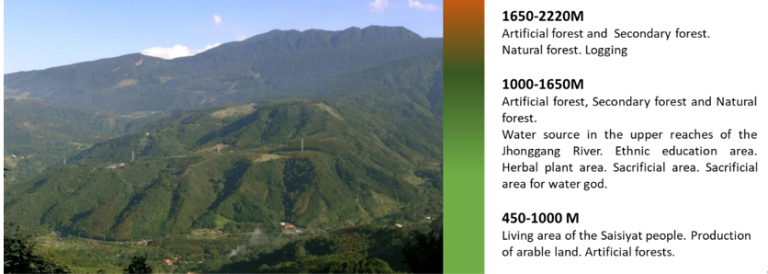
Looking from the Jiali Shan triangulation point, at its altitude of 2220 meters, spreading downwards to the west, one sees many boulders, streams, and fault lines. This is the water source in the upper reaches of the Jhonggang River. Along the Danan River to the reservoir, it supplies important watersheds in the middle and lower reaches of the Greater Miaoli region. Its lush manmade, secondary and primary forests are diverse in their landforms and faunal and floral species composition. According to a 2020 survey by Hsinchu Forest District Office of the Forestry Bureau, a total of 433 species of animals and plants were found in the Penglai Village area, as shown in the Table 1 below.
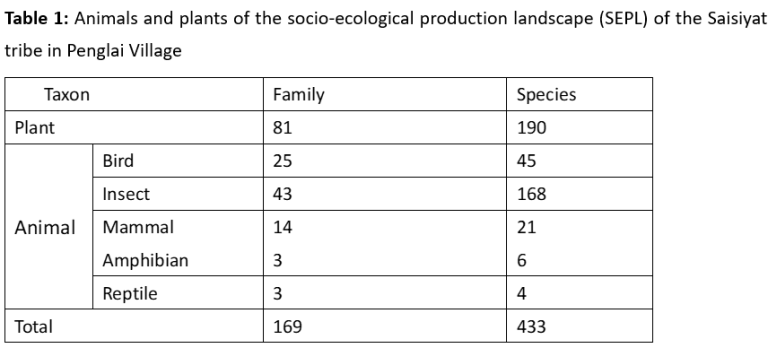
2. Rationale
In February 2018, after the Saisiyat people and the Forestry Bureau signed the partnership agreement, co-management of the forests became a key component for its implementation. The partnership arrangement has helped the Saisiyat tribes to solve their long-term conflict with the government, create green economy, and improved local livelihoods. Since 2018 to date, the main objectives of the co-management scheme have included: (1) establishing the Saisiyat Cooperative to improve tribal management and benefit-sharing activities; (2) fostering partnership ties and expanding social welfare; (3) strengthening tribal cohesion, sense of place, counselling services to the elderly and adjustment of returned migrant youth ; (4) leveraging on the principles of green economy and self-sufficiency to revive Indigenous culture, develop Satoyama industries and local brands.
3. Activities and results
During these five years (2018-2023), the Saisiyat Cooperative has been working hand in hand with the Forestry Bureau as well as various local partners, including Penglai Elementary School and Penglai Police Station. Their joint activities, based on the three-fold approach and six socio-ecological objectives of the Satoyama Initiative, have contributed to local sustainability and resilience of the Saisiyat SEPL. Presented below are the main types of activities and their relevant outcomes.
3.1 Under-forest economy
Beekeeping is an essential part of the Saisiyat culture, the art of which had unfortunately been lost in the recent decades. In June 2018, having studied beekeeping technology at the Forestry Bureau, the tribal community started proactively reviving apiculture in the area (Figure 2). In early 2020, an investigation by tribe found out that the rapid development of the beekeeping industry did not result in the anticipated ecological balance. In was determined that the number of bee farms and beehives needed to be controlled to stay within sustainable ecological limits. At the same time, local production emphasis was shifted to diverse, small quantity but high quality under-forestry produce, which, in addition to forest honey and pollen, also included log-cultivated shiitake mushrooms, camellia oil, seasonal fruits and vegetables (Figures 3 and 4). These efforts have allowed the tribe to diversify its ecosystem-based sources of income, caring both for the local environment and local livelihoods – the Saisiyat version of green economy.



3.2 Forestry operations
The Saisiyat people learned logging techniques from the Japanese in the 1920s while working as laborers during the Japanese occupation and in the following years of the Republic of China (between 1945-1970). In 2021, following an almost four decades gap in legal forestry operations, the local people received training from the Forestry Bureau focused on the skidding techniques, raising of seedlings and afforestation practices. In 2022, the Saisiyat Cooperative began to engage in forestry management in the Nanzhuang forest area, becoming the first Indigenous forestry management team in Taiwan’s history. These efforts have raised employment and increased the cumulative income of the tribe. On May 4, 2023, they obtained an international forest management certification from the Forest Stewardship Council (FSC) (Figure 5). To further promote local forestry operations, on May 16, 2023, the Hsinchu Forest District Office, in line with the environmental, social and governance (ESG) business framework, cooperated with China Airlines to adopt 1.7 hectares of forest land in 28 logging areas within Nanzhuang, where the Saisiyat Cooperative had already planted 4,250 Taiwania tree species (Figure 6).
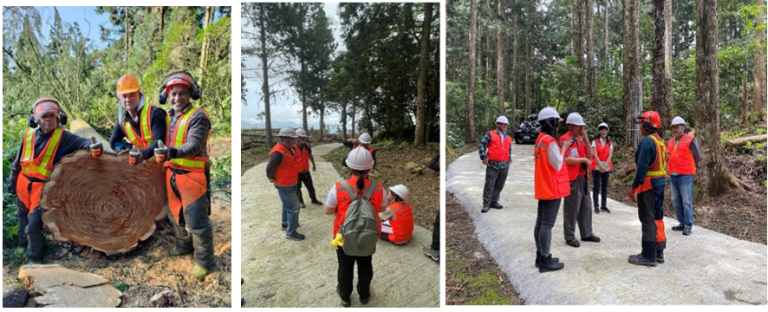
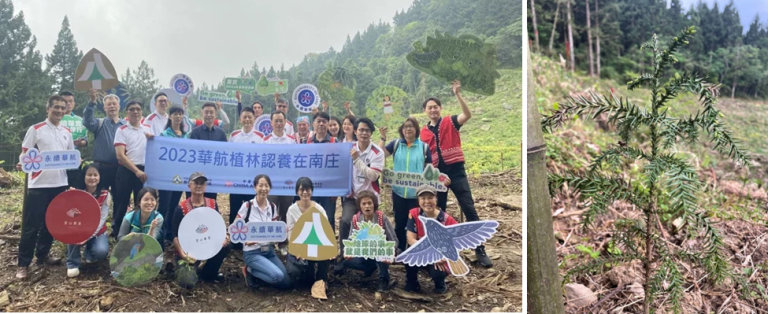
3.3 Forest patrol
Penglai Village is where the Saisiyat people have lived for generations, but in recent decades it had become an area devastated by illegal logging. In 2019, the Saisiyat Cooperative established a forest patrol team in Jiali Shan. As of 2022, a total of 1030 patrols have been made, which found and reported 12 illegal logging operations, and have successfully assisted the Hsinchu Forest District Office in uncovering 2 cases of illegal logging. The forest patrol teams help to collect trash left near the hiking trails, actively promote forest conservation measures and fire safety rules to hikers, assist in reporting of lost hikers as well as work with the Forestry Bureau on prevention and reporting of the forest fires.
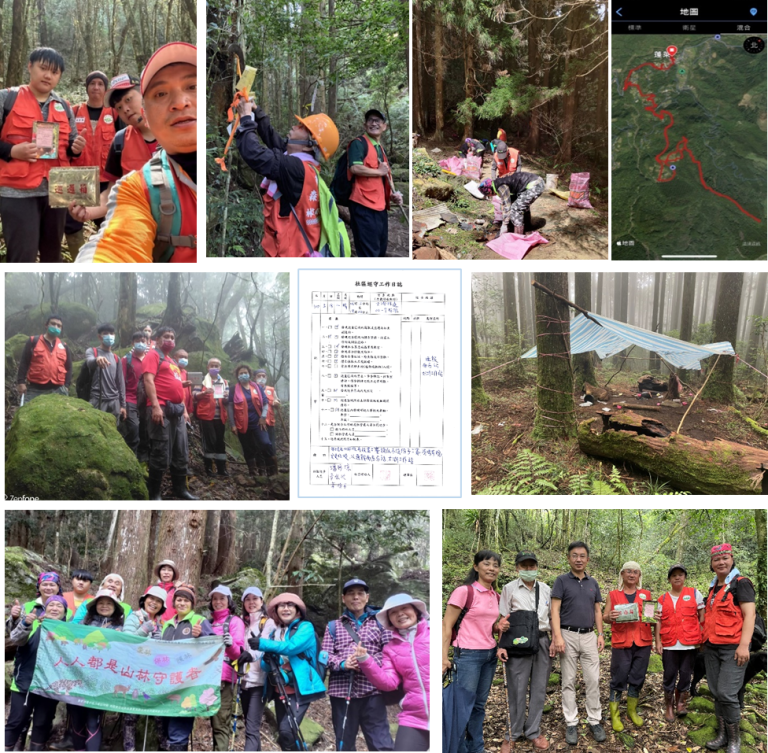
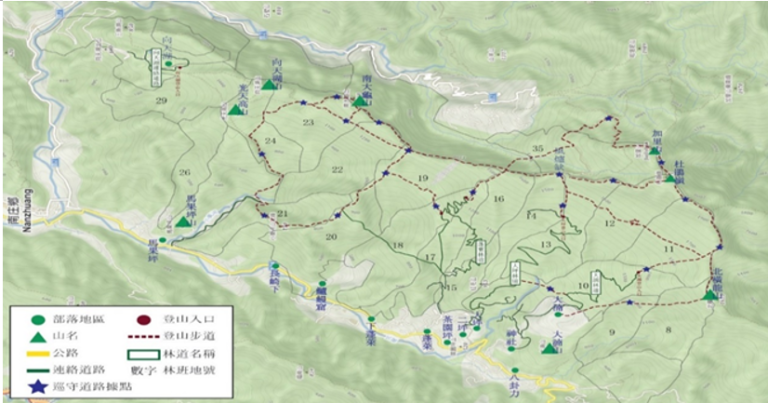
3.4 Forest stations
In the early days, the Forestry Bureau inspection stations used to be called by the Saisiyat people as “the home of the devil”. Nowadays, one of such forest stations in Penglai Village, Nanzhuang Township has been refurbished by the Hsinchu Forest District Office in place of an old one and transformed into a shared space by the Saisiyat community (Figure 8). Today, this forest station has become a multi-functional platform for the development of tribal industries as well as a place with many emotional connections. It is operated by the Saisiyat Cooperative and supported by the Hsinchu Forest District Office based on the principles of co-management, benefit-sharing and sustainability.
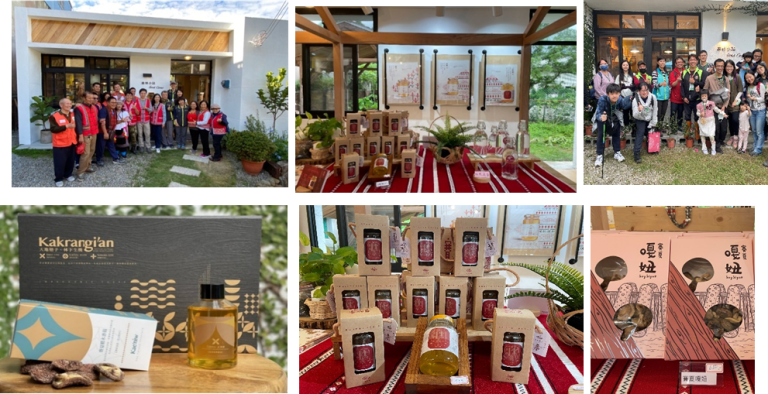
3.5 Eco-tourism
The Saisiyat Secret Space is currently a place where the Saisiyat Cooperative and the Forestry Bureau co-manage the forest. It has, since ancient times, been a place for the Saisiyat traditional education and an area for growing local herbs and plants. This linkage to traditional ecological knowledge of the Saisiyat people makes the concept of the Satoyama Initiative so familiar to the local community and easily understood by the visitors (Figure 9). From 2019 to 2022, the number of visitors exceeded 10000, and as many as 50 government agencies and organizations, 8 forest district offices under the Forestry Bureau, environmental protection groups, schools, people from 15 Indigenous ethnic groups, and general visitors have come to the site for exchange. To protect its local environment and take into account the carrying capacity, the site has not yet been officially opened to the public. It adopts a visit-by-appointment system that is limited to 100 visitors per day. Visitation is closed for 30 days during the rainy season every year, so that the vegetation can fully recover. Such eco-tourism arrangement has not only helped in terms of placemaking, but has also revived the previously disappearing forest culture of the Saisiyat people.
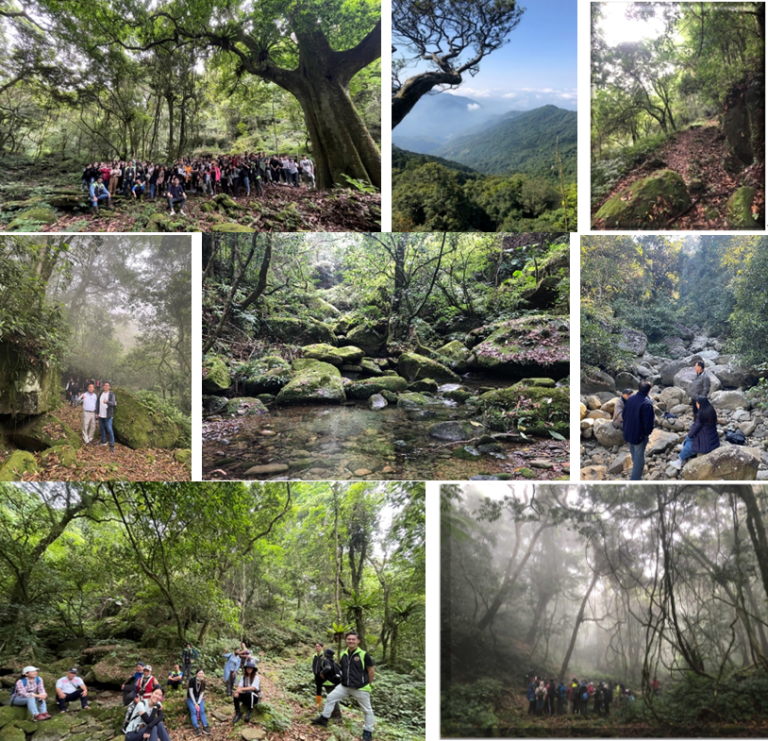
3.6 Circular economy
In 2020, the Saisiyat Cooperative started developing a circular economy by recycling by-product of the forestry operations and adding its value by creating useful and innovative local products. Since 2021, using what resources can be recycled from leaves of herbaceous plants as well as leftover branches, the tribe has been producing herbal distillates and essential oils, while its elders have been collecting and preparing local medicinal plants. Such diverse green products have not only laid the foundation of the Saisiyat circular economy but have also been well received by the consumers.
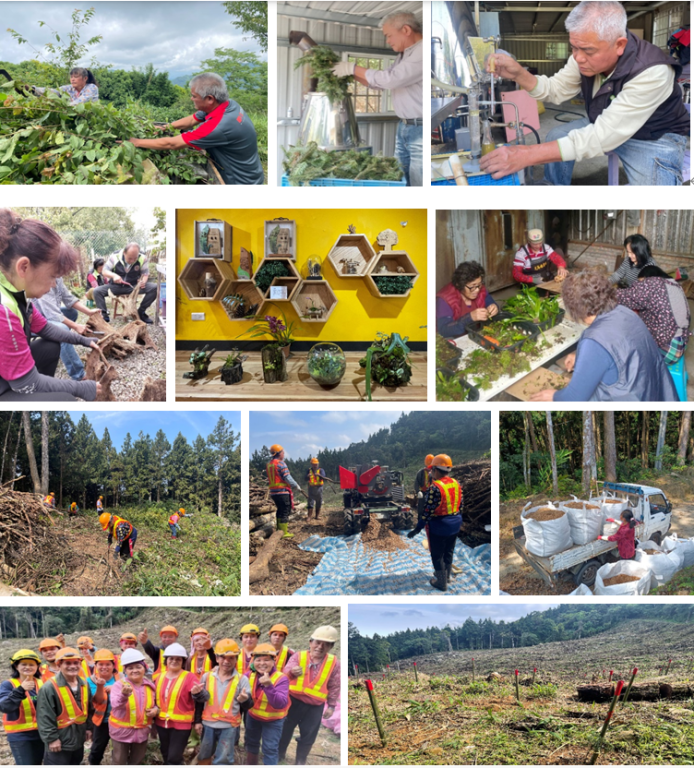

3.7 Restoring rare plants and revitalizing local culture
Culture is the at the very core of the any community. From September 2018 to May 2023, since the tribe and the government began co-managing the forests, countless aspects of Saisiyat culture and biodiversity have been restored. Among the most prominent cultural rituals has been the revival of the coming-of-age ceremony of the Saisiyats, which had been stagnant for 50 years (Figure 11). Some of the rare plants restored by the co-management scheme include Kudzu, which is also known as the mother’s flower by the Saisiyat, who use it to represent the greatness of mothers and women; and Stout camphor tree also known as “the tree of life” discovered in the wild by the Japanese scholar Yumoto Yataro in Penglai Village in 1926. Another successful example is the Nansho Daidai Sour Orange (Citrus taiwanica) – a critically endangered plant included in the Red List of Threatened Species by the International Union for Conservation of Nature (IUCN) (Figure 12). The Marbled Jewel Orchids (Anoectochilus formosanus), which was extinct in the wild of Nanzhuang due to illegal harvesting pressure, was reintroduced to the traditional territory of Saisiyat tribe. Thus, the Saisiyat example demonstrates the power of tribal-state partnership and co-management towards the revival of bio-cultural identities.

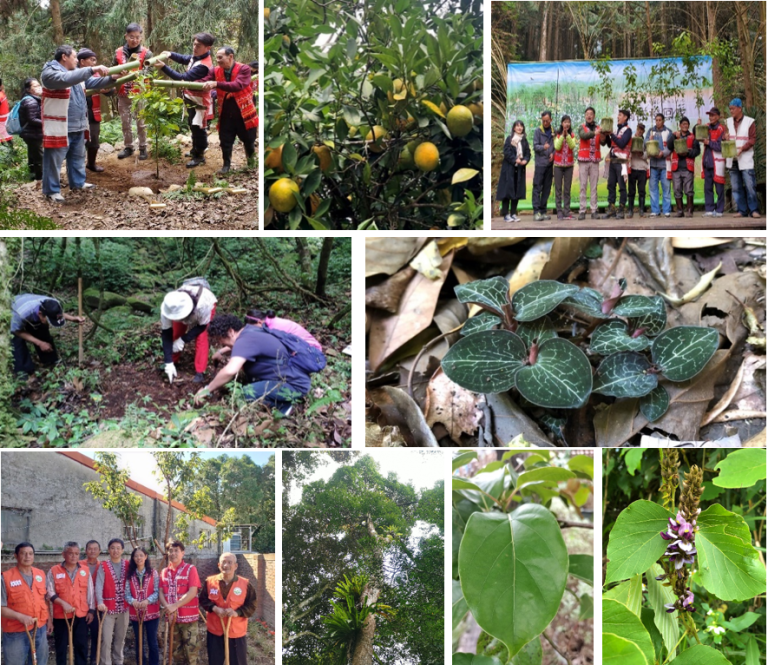
Participation and cooperation of multiple stakeholders
Since 2018, the Saisiyat Cooperative has developed strong and lasting partnership ties with a number of key stakeholders: the Hsinchu Forest District Office, Penla Elementary School, police station, fire brigade, Nanzhuang Township Office, Miaoli County Government, and many others (Figures 13-15). These connections have helped to build consensus and work together in putting revitalization ideas into practice.


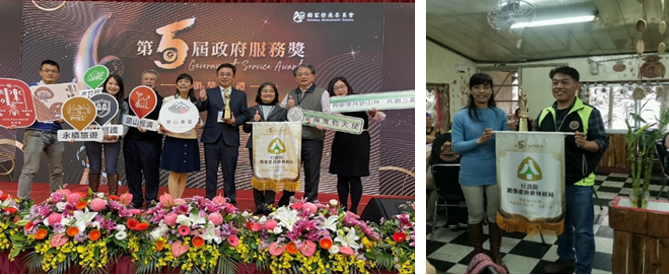
4.Lessons learned and ways forward
This case study is an actively ongoing effort (from February 2018 to date) towards sustainable and mutually beneficial co-management of the forestry resources by the Saisiyat people and the Forestry Bureau. While its experiences continue to grow, some of the invaluable lessons are presented below.
Dilemma and persistence.
When the Hsinchu Forest District Office assisted the Saisiyats to establish the Saisiyat Coperative in April 2019, many of the local tribesmen still had serious doubts: only 7 out of 10 local leaders joined the Cooperative. In other words, the tribespeople watched and waited, mocked and ridiculed the Cooperative unable to believe that the partnership would eventually work. Faced with the countless problems in the Penglai Village, such as distrust of the Forestry Bureau, lack of stable income and poor living conditions, the Saisiyat Cooperative, insisted that the tribe had to rely on its own labor to reap its own rewards. This persistence, as challenging as it can be, is what makes the Saisiyats proud of their achievements and self-sufficiency.
Sound organization and shared benefits.
Since the establishment of the Saisiyat Cooperative, the satoyama practices of its members have been guided and supported by the Hsinchu Forest District Office. Today, the operation of the Cooperative has not only allowed for a diversified and advanced development of the under-forest industry, but it has also followed the Saisiyat people’s cultural traditions of benefit sharing and co-prosperity, while also promoting independent business management practices. The Cooperative holds monthly community meetings on the 10th day of each month to review social affairs and to share the operating income of the month openly and fairly among all tribal members, while also taking into account the basic care of the elderly and the weak (Figure 16).
Return of tribal youth and inter-generational solidarity.
Eventually, establishment and development of the Saisiyat Cooperative has not been affirmed and supported by the tribe, but, most importantly, it has encouraged the tribal youth to return to their ancestral Saisiyat home. At present, the number of members in the cooperative has reached 122 and 19 young people have returned. Inter-generational and inter-personal solidarity is yet the greatest change that has occurred to date. It has demonstrated that with a positive effort and mutual trust the locals can jointly rediscover and revive their shared culture and values.
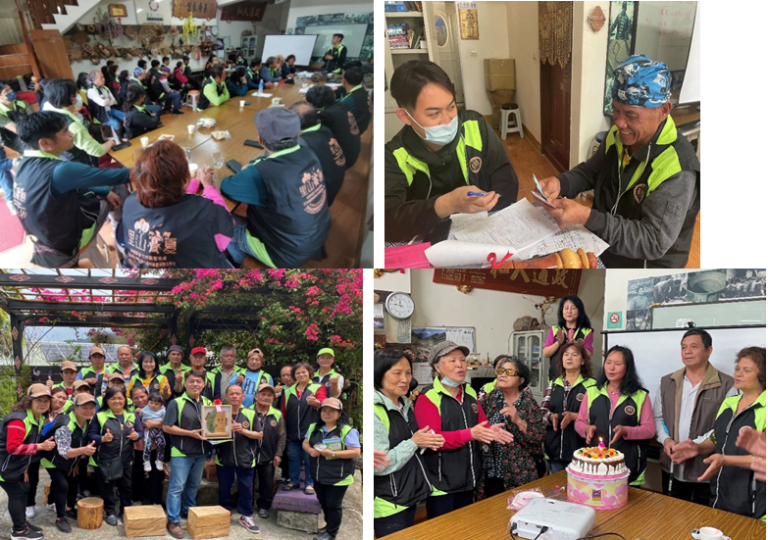
The Saisiyat community and the Forestry Bureau have gone from the state of doubting one another to working hand in hand as loyal partners. The tribal people of the Penglai Village have deeply appreciated the signing of the partnership agreement, have appreciated the benefits it has brought over such a short period of time and are eager to work on implementation of the Satoyama Initiative for years to come. The mutually beneficial situation of the tribe and the government working together have given the Saisiyat the vision of a sustainable future ahead. The tribe has even said that they would no longer call the Forestry Bureau a “devil” but would dub it an “angel” instead.
In the future, adhering to the goals set by the Satoyama Initiative, UN Sustainable Development Goals and the Kunming-Montreal Global Biodiversity Framework, the Saisiyat people and the Forestry Bureau will continue their close partnership to realize a harmonious coexistence of humans and nature for the generations to come.

